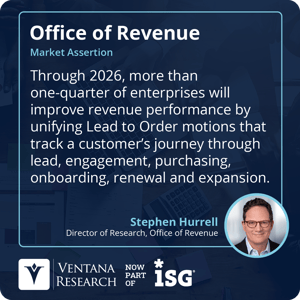Much development and marketing resource is being directed at technology that supports tracking and managing the customer experience (CX) and identifying prospects. All of this is good for business and highlights some of the exciting potential for artificial intelligence (AI) and generative AI (GenAI) to really accelerate the basic need of matching buyers and sellers to create more efficient markets for the benefit of all. But part of the B2B customer experience also revolves around quality and efficacy of the buying process, speed and accuracy of fulfillment commitments and ease of re-ordering. Though not always thought of as part of the selling experience, these processes are nevertheless important to not only start the intended business relationship off on the right foot, but also to the overall aim of a positive CX.
Although it could be viewed as a cliché, the phrase “service is the product” contains more than a grain of truth. As discussed in an earlier analyst perspective, for recurring revenue business models, and for a substantial number of B2B transactions, sustained engagement is a necessary precursor for a profitable relationship. So, in this instance, all aspects of a prospect's journey to becoming a long-standing and repeat customer should be areas of focus to ensure processes, people and technology are aligned and working together.
Sometimes referred to as lead to cash, we feel that this term lacks the broad representative scope and importance that these activities now represent. We prefer revenue life cycle management as this better describes the business process that encompasses more modern pricing and revenue models that most enterprises have or are planning to adopt. The economics of these recurring revenue models dictate the necessity of a sustained and successful relationship to achieve profitability. In B2B models, customers do not represent one-time transactions but an active continuum of activities or, as we say, a life cycle.
A key step toward the revenue life cycle approach is to look at processes that support and link discrete activities that cross teams that support this CX and identify the needed technology to ensure that the necessary data and information is automatically populated, routed, and verified at each step. This ensures that not only the initial engagement runs smoothly, but subsequent changes and amendments to orders, plans and contracts also flow through automatically. In this way, the customer is shielded from internal organization structures such as disparate business units and systems.
With many transactions intended for bundles or composite products, combining physical and digital products, and services fulfillment and delivery, often needs to be orchestrated across both internal business units and departments as well as across calendars. So, quotes, orders, subscription plans, and contracts need to be digitally stored, not just as a digital document, such as a pdf, but with the important terms of the order and contract stored as data. In this way, relevant information around the scale and timing of entitlements and obligations can be efficiently processed. This is vital, as for a period the accurate order and term information exists only in the contract or order; opportunity data rarely represents the final agreed-upon terms.
Overall, we assert that through 2026, more than one-quarter of enterprises will improve revenue performance by unifying Lead to Order motions that track a customer’s journey through lead, engagement, purchasing, onboarding, renewal and expansion.
through lead, engagement, purchasing, onboarding, renewal and expansion.
An unfortunate truism of life is that mistakes occur, even in the best-defined processes, when one person or team hands off to another. And mistakes are often the result of incorrect or missing information. Again, this emphasizes the importance of having digitized processes that facilitate through processing of transactions and events as well as ensure accurate data is readily available to those who will have customer interactions at any stage of the revenue life cycle process.
Once implemented, digitized processes lay the foundation for process improvement and can be used to detect bottlenecks or unreasonable delays. In addition, digitized interactions will be the future basis to be able to deploy AI to help personalize automated interactions between buyer and seller. We recommend that all B2B enterprises focus on not only the typical early- to mid-stage Customer Relationship Management (CRM) lead and opportunity sales activities, but also on those activities that link the sales opportunity back to the rest of the enterprise in terms of quote, contract, entitlements, fulfillment, and delivery as well.
Automating the revenue life cycle should be on every enterprise's road map as it will not only impact your customer revenue life cycle today, but also sets the stage for continual improvements by maintaining competitive advantage through superior CX and sustained customer engagement.
Regards,
Stephen Hurrell

 through lead, engagement, purchasing, onboarding, renewal and expansion.
through lead, engagement, purchasing, onboarding, renewal and expansion.








